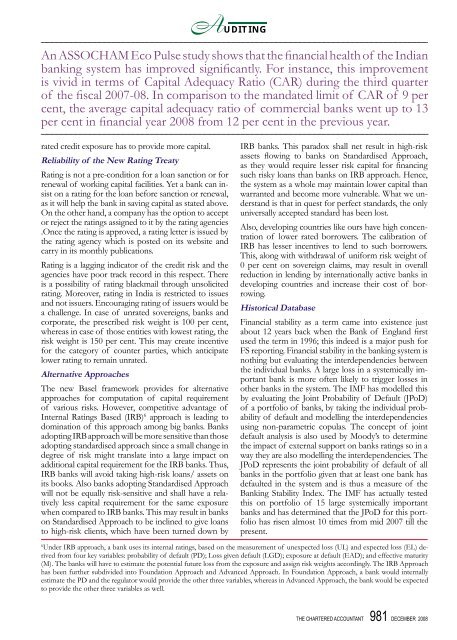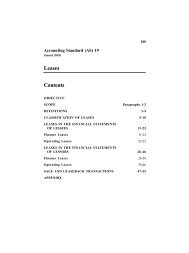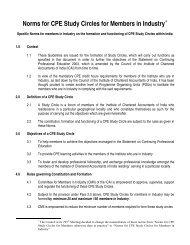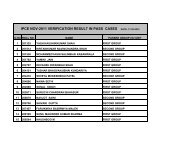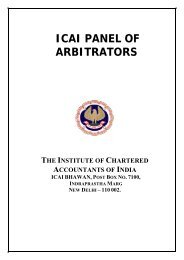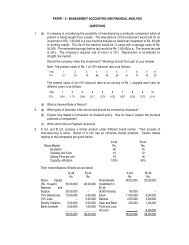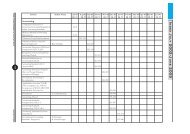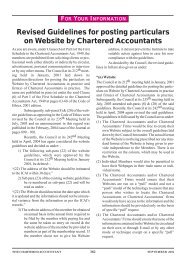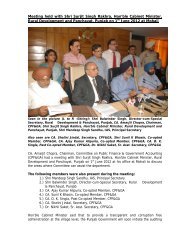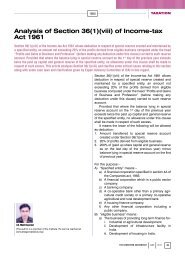The Chartered Accountant
The Chartered Accountant
The Chartered Accountant
Create successful ePaper yourself
Turn your PDF publications into a flip-book with our unique Google optimized e-Paper software.
AUDITING<br />
An ASSOCHAM Eco Pulse study shows that the financial health of the Indian<br />
banking system has improved significantly. For instance, this improvement<br />
is vivid in terms of Capital Adequacy Ratio (CAR) during the third quarter<br />
of the fiscal 2007-08. In comparison to the mandated limit of CAR of 9 per<br />
cent, the average capital adequacy ratio of commercial banks went up to 13<br />
per cent in financial year 2008 from 12 per cent in the previous year.<br />
rated credit exposure has to provide more capital.<br />
reliability of the new rating treaty<br />
Rating is not a pre-condition for a loan sanction or for<br />
renewal of working capital facilities. Yet a bank can insist<br />
on a rating for the loan before sanction or renewal,<br />
as it will help the bank in saving capital as stated above.<br />
On the other hand, a company has the option to accept<br />
or reject the ratings assigned to it by the rating agencies<br />
.Once the rating is approved, a rating letter is issued by<br />
the rating agency which is posted on its website and<br />
carry in its monthly publications.<br />
Rating is a lagging indicator of the credit risk and the<br />
agencies have poor track record in this respect. <strong>The</strong>re<br />
is a possibility of rating blackmail through unsolicited<br />
rating. Moreover, rating in India is restricted to issues<br />
and not issuers. Encouraging rating of issuers would be<br />
a challenge. In case of unrated sovereigns, banks and<br />
corporate, the prescribed risk weight is 100 per cent,<br />
whereas in case of those entities with lowest rating, the<br />
risk weight is 150 per cent. This may create incentive<br />
for the category of counter parties, which anticipate<br />
lower rating to remain unrated.<br />
Alternative Approaches<br />
<strong>The</strong> new Basel framework provides for alternative<br />
approaches for computation of capital requirement<br />
of various risks. However, competitive advantage of<br />
Internal Ratings Based (IRB) 6 approach is leading to<br />
domination of this approach among big banks. Banks<br />
adopting IRB approach will be more sensitive than those<br />
adopting standardised approach since a small change in<br />
degree of risk might translate into a large impact on<br />
additional capital requirement for the IRB banks. Thus,<br />
IRB banks will avoid taking high-risk loans/ assets on<br />
its books. Also banks adopting Standardised Approach<br />
will not be equally risk-sensitive and shall have a relatively<br />
less capital requirement for the same exposure<br />
when compared to IRB banks. This may result in banks<br />
on Standardised Approach to be inclined to give loans<br />
to high-risk clients, which have been turned down by<br />
IRB banks. This paradox shall net result in high-risk<br />
assets flowing to banks on Standardised Approach,<br />
as they would require lesser risk capital for financing<br />
such risky loans than banks on IRB approach. Hence,<br />
the system as a whole may maintain lower capital than<br />
warranted and become more vulnerable. What we understand<br />
is that in quest for perfect standards, the only<br />
universally accepted standard has been lost.<br />
Also, developing countries like ours have high concentration<br />
of lower rated borrowers. <strong>The</strong> calibration of<br />
IRB has lesser incentives to lend to such borrowers.<br />
This, along with withdrawal of uniform risk weight of<br />
0 per cent on sovereign claims, may result in overall<br />
reduction in lending by internationally active banks in<br />
developing countries and increase their cost of borrowing.<br />
historical database<br />
Financial stability as a term came into existence just<br />
about 12 years back when the Bank of England first<br />
used the term in 1996; this indeed is a major push for<br />
FS reporting. Financial stability in the banking system is<br />
nothing but evaluating the interdependencies between<br />
the individual banks. A large loss in a systemically important<br />
bank is more often likely to trigger losses in<br />
other banks in the system. <strong>The</strong> IMF has modelled this<br />
by evaluating the Joint Probability of Default (JPoD)<br />
of a portfolio of banks, by taking the individual probability<br />
of default and modelling the interdependencies<br />
using non-parametric copulas. <strong>The</strong> concept of joint<br />
default analysis is also used by Moody’s to determine<br />
the impact of external support on banks ratings so in a<br />
way they are also modelling the interdependencies. <strong>The</strong><br />
JPoD represents the joint probability of default of all<br />
banks in the portfolio given that at least one bank has<br />
defaulted in the system and is thus a measure of the<br />
Banking Stability Index. <strong>The</strong> IMF has actually tested<br />
this on portfolio of 15 large systemically important<br />
banks and has determined that the JPoD for this portfolio<br />
has risen almost 10 times from mid 2007 till the<br />
present.<br />
6 Under IRB approach, a bank uses its internal ratings, based on the measurement of unexpected loss (UL) and expected loss (EL) derived<br />
from four key variables: probability of default (PD); Loss given default (LGD); exposure at default (EAD); and effective maturity<br />
(M). <strong>The</strong> banks will have to estimate the potential future loss from the exposure and assign risk weights accordingly. <strong>The</strong> IRB Approach<br />
has been further subdivided into Foundation Approach and Advanced Approach. In Foundation Approach, a bank would internally<br />
estimate the PD and the regulator would provide the other three variables, whereas in Advanced Approach, the bank would be expected<br />
to provide the other three variables as well.<br />
THE CHARTERED ACCOUNTANT 981 DECEMBER 2008


